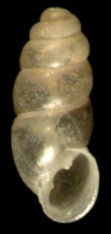Classification
The scientific name is Gastrocopta corticaria; however, it is most commonly known as Bark Snaggletooth (Say, 1816). The Latin meaning behind the scientific name includes: gastro meaning stomach, copta meaning a cut or slice, cortic meaning bark like, and aria is unknown (Gillis). The origin of the common name is also unknown.
The complete classification of Bark Snaggletooth has the domain of
Eukaryota, the kingdom
kingdom
 of Animalia, the phylum of Mollusca, the class of
Gastropoda, the order of Stylommatophora, the family of Pupillidae, the
genus of Gastrocopta, and the species of Gastrocopta corticaria
(www.zipcodezoo.com).
Bark Snaggletooth is classified in the domain of Eukaryota because it is a
multicellular organism with a nucleus (Roberts et al, 2007). It is classified in the kingdom Animalia because it is mobile and heterotrophic(Roberts
et al, 2007). It is classified in the
phylum Mollusca because it has a nervous system and a mantle for breathing
and excretion (Roberts et al, 2007). It is classified in the class Gastropoda because its body partakes
in coiling and torsion (Roberts et al, 2007). It is classified in the order of Stylommatophora
because it breathes air, has long pedal glands located below a membrane, and
has retractile tentacles (www.zipcodezoo.com). It is classified in the family of Pupillidae
because it has haploid chromosomes varying from 26-30 (www.zipcodezoo.com). It is classified in
the genus of Gastrocopta because it has a blade-like tooth (Pilsbry,
1948). It is
finally then classified into the species of Gastrocopta corticaria
because its teeth are more reduced than those of other Gastrocopta
and it is found on the bark of trees (black walnut) (Pilsbry, 1948).
of Animalia, the phylum of Mollusca, the class of
Gastropoda, the order of Stylommatophora, the family of Pupillidae, the
genus of Gastrocopta, and the species of Gastrocopta corticaria
(www.zipcodezoo.com).
Bark Snaggletooth is classified in the domain of Eukaryota because it is a
multicellular organism with a nucleus (Roberts et al, 2007). It is classified in the kingdom Animalia because it is mobile and heterotrophic(Roberts
et al, 2007). It is classified in the
phylum Mollusca because it has a nervous system and a mantle for breathing
and excretion (Roberts et al, 2007). It is classified in the class Gastropoda because its body partakes
in coiling and torsion (Roberts et al, 2007). It is classified in the order of Stylommatophora
because it breathes air, has long pedal glands located below a membrane, and
has retractile tentacles (www.zipcodezoo.com). It is classified in the family of Pupillidae
because it has haploid chromosomes varying from 26-30 (www.zipcodezoo.com). It is classified in
the genus of Gastrocopta because it has a blade-like tooth (Pilsbry,
1948). It is
finally then classified into the species of Gastrocopta corticaria
because its teeth are more reduced than those of other Gastrocopta
and it is found on the bark of trees (black walnut) (Pilsbry, 1948).
Check out the Habitat page to find out where Bark Snaggletooth lives!
Home
